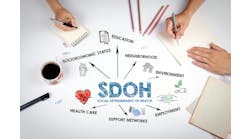Incorporating social determinants of health (SDOH) data into providers’ workflows has long been a challenge, starting at the basic infrastructure level around who is responsible for addressing social needs or what the best approaches to the problem are. For instance, a study published last fall in JAMA Open Network, inclusive of responses from more than 2,100 physician practices and nearly 800 hospitals across the country, found that just one-quarter of U.S. hospitals and 16 percent of physician practices self-report screening patients for social determinants of health such as food, housing, transportation, utilities, and interpersonal violence needs.
As one could imagine, if the majority of providers are not even screening patients for SDOH, integrating this type of data into a health information exchange (HIE) network is going to pose great challenges. To this end, the Regenstrief Institute and collaborators, including the state of Indiana, Indiana University and the Indiana Health Information Exchange, recently launched the Indiana Network for Population Health (INPH), designed to provide the secure exchange of comprehensive data—especially information on social determinants of health such as housing stability and access to nutritious food—to researchers, policy makers, healthcare providers and others on the frontlines fighting opioid and other addictions.
"It's not that physicians have totally ignored social determinants of health, but impactful information—such as the fact that the patient had to take time off from a low-paying job and ride two buses to get to the doctor's office—isn't typically collected in electronic medical records," says Brian Dixon, Ph.D., director of public health informatics at Regenstrief Institute and Richard M. Fairbanks School of Public Health at IUPUI. He adds, “A clinician may have noted in unstructured free text in the medical record that an individual is a heavy smoker or homeless, for example, but free text information, with its lack of uniformity, can be difficult to extract correctly. Will a computer extracting data from the patient's file capture the phrase "has no safe home" or simply ignore the first two words and see "safe home" and not make this information accessible to community programs like the YMCA or homeless shelter organizations who might help the patient find a better place to live?”
As such, the Indiana Network for Population Health—which is an extension of the Indiana Network for Patient Care, currently holding approximately 12 billion pieces of clinical data—will aim to broadly enhance health surveillance in the community, tracking well-known diseases such as Hepatitis C and diabetes, and new ones like COVID-19, Dixon says. Recently, Dixon spoke with Healthcare Innovation about the new network, its core goals, and why SDOH data exchange will be so important going forward.
Can you describe the impetus behind the network’s launch?
When looking at the health sector and what’s been important to it, there has been so much discussion about the need to bring SDOH data together in combination with clinical data. And this builds on our 15- to 20-year history of doing health information exchange for clinical purposes. In the last few years we have had discussions with our ACOs, and our healthcare systems that have population health units, about their [greatest] needs, and it came to the forefront that they were interested in getting SDOH data from the HIE. This could either mean data they would enter into their systems, or that we could leverage from other sources.
We have been doing information exchange for more than 15 years for individual patient care, and at this juncture it’s necessary to pivot to create a new platform to support population health. This means looking at data from a population level, and those conversations just naturally introduced a real focus on SDOH, because it is data that can come from outside the health system. In a population health context, you are interested in where people live, their behaviors, where they work, and their socioeconomic factors and circumstances, and you are bringing that into care for an individual patient and at a population level. It became evident that we need to focus on population health and SDOH, because these were areas where our hospital and health system partners were putting together strategies for how they would access and use this data, and they have looked to us for input and advice.
To date, what have been the core challenges been around SDOH data sharing?
There are two main barriers, of several, that have plagued the whole industry. The first is the time-consuming nature of asking individual clinicians to record this information. Several years ago when it became clear that SDOH data was important for guiding care decisions, people rushed to say let’s have clinicians collect that data, or they’d delegate it to a nurse or someone else. That creates a challenge because they’re already under pressure to take care of more people with faster timelines and lots of documentation. So that’s a big barrier: if we’re asking people to enter this data, it puts a real time burden on them.
The second thing is that there isn’t a lot of structure or standardization around [SDOH] data, and people have struggled with that over time. Now, the LOINC standard that the Regenstrief Institute has maintained has added structured codes for SDOH data, and SNOMED has [also] added concepts for encoding SDOH. We have been working on the semantic interoperability side for the last few years so that we can structure this data, but we are still stuck the time-burden challenge.
To address that, we have tried to take an approach where we look at SDOH data that can be accessed from outside someone sitting at a terminal entering it. It’s both a challenge and an opportunity; there are other agencies like the U.S. Census Bureau and social service agencies collecting SDOH data, so if we refer someone from the healthcare system to a food pantry or to receive services from a community-based organization, for example, those organizations collect data on their clients. Is there a way we can tap into that data to bring population-level information into the healthcare system, rather than reinvent the wheel and enter data on a person level? That’s been our initial focus at the HIE level; bringing in that data from outside the health system and making it digestible for clinicians.
And the infrastructure that enables clinicians to easily collect SDOH data has been lacking, right?
Part of the challenge is that when someone got trained to be a doctor five, ten, or 20 years ago, there wasn’t explicit training on how to deal with the social determinants. What do you do with that patient and where do you refer them? But in the last few years we have seen a restructuring of the health system Infrastructure so that when these issues prop up, it’s in the purview of a social worker or a particular nurse in the clinic to say OK, we have identified this issue with a patient, now we will bring in an expert to work on that issue with the patient. It’s the same way we are now bringing in pharmacists to work with primary care to help with medication management. So now we have to adapt EHRs and other technology in healthcare to support those roles.
How will you measure success, both in the near- and long-term?
In the short-term, we are leveraging our new infrastructure to support our response to the opioid epidemic, which has been a huge [priority] for us pre-COVID, of course. So we are measuring success in the short-term on the number of data sources we can successfully integrate into our environment and make available to individuals for information exchange.
In the long-term, we will be working with partners to develop specific dashboards and tools that meet their information needs around social determinants at the population level. So, how many health system partners can we have on our platform that are using it for community-based needs assessments they have to do? How many partners can we have that are using this data to support initiatives around diabetes, obesity, or other high-priority health challenges in the local community? A challenge for us is supporting the localization of social determinant needs; every community is a little different.


